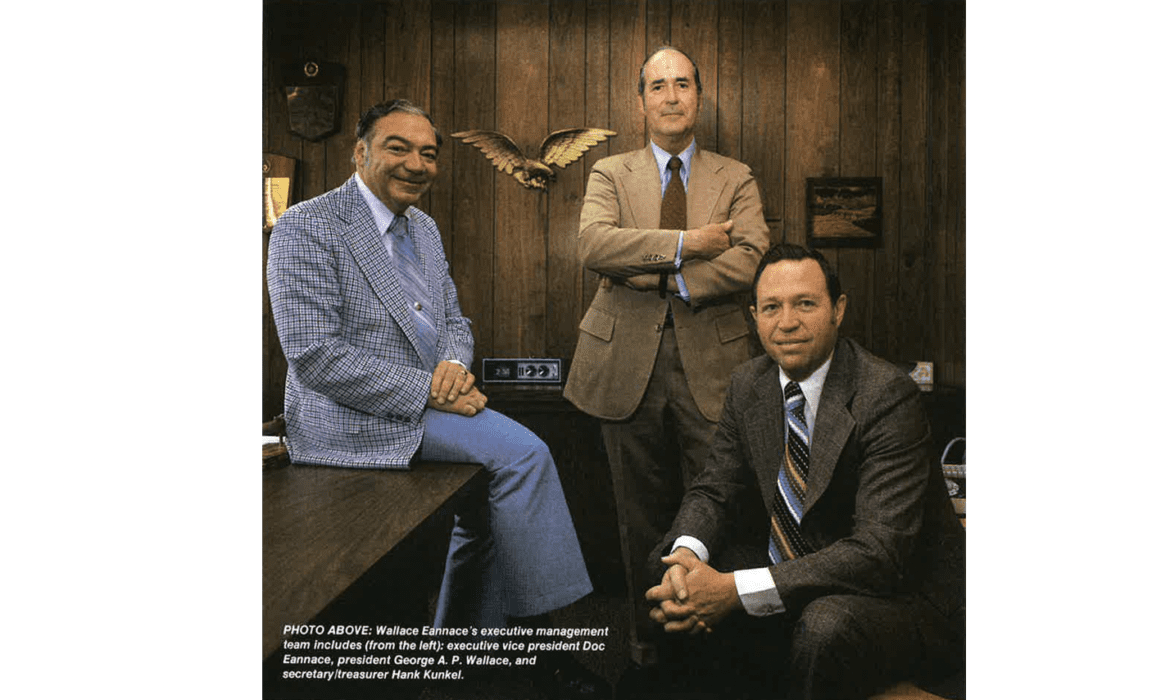With its current involvement in steam and hydronic schooling for local industry, Wallace Eannace remains faithful to a long tradition of technical education and service to the customer. By name, Wallace Eannace is a comparatively new operation, having been incorporated in 1970. But it is actually the offspring of one of the more venerable MIR firms in our industry’s history, John G. Kelly, Inc., which places Wallace Eannace among the oldest Rep organizations in our field.
Founded in 1924 by the late John G. Kelly, the original company was one of the first manufacturers representatives in the metropolitan New York area. When Mr. Kelly, formerly a boiler salesman for Pierce Butler-Pierce, opened a warehouse on Long Island in the late ’30s, this was a first for local industry as well.
Much of the company’s rise to prominence, however, came under the leadership of the late Harold Schmidt, who joined the company in 1930 and acquired it from Mr. Kelly upon his retirement in 1941. Although the transaction occurred at the outset of our country’s involvement in World War II, the firm managed to survive those lean years. With the return of peace in 1945,Schmidt demonstrated his optimism that the plumbing supplies market would boom again by opening a 12,500 sq. ft. office-warehouse complex in Long Island, City. By 1947, Schmidt’s optimism was confirmed, as business picked up sharply for Kelly, Inc. and its principals, many of whom are still with Wallace Eannace today. They include: Bell & Gossett, Lawler, Marshalltown Instruments, Watta Fluid Power, Inc. and Hoffman Specialty, one of the first lines Mr. Kelly acquired in the ’20s.
(In addition to the above, Wallace Eannace Associates also represents Danfoss, Inc., ITI Domestic Pump, Flexonics, Keckley, ITT McDonnell & Miller, Penberthy and Yarway.)
A Change in Emphasis
Perhaps Harold Schmidt’s most significant contribution to the growth of the Kelly firm was in the reshaping of its marketing emphasis, moving away from standard plumbing commodities to the then new specialty products, designed to improve the operating efficiency of plumbing and heating systems. While hydronic specialties had historically been an important element in the firm’s product offering, John G. Kelly, Inc. would henceforth refer to itself as a “specialist in specialties.”
Because of the technical sophistication of many of its lines, a successful marketing strategy necessarily included a strong commitment to engineering assistance and education for the customer. This expertise became a trademark for the company in the marketplace: a John G. Kelly Rep wasn’t just an order taker, but a salesman who had to first sell an idea or a technical approach to a problem before he could move his product.
“Our men might spend up to 85% of their time on engineering service,” current Wallace Eannace president George A. P. Wallace told this magazine in a J959 article on Kelly, Inc. “It is more a ‘sales engineering’ approach then pure selling in the usual sense of the word. You are always training and showing how.”
This responsibility to show the customer “how” gave rise to the company’s program of all-day training schools for wholesalers, contractors and consulting engineers. Dealing primarily with practical engineering and product applications for wet heat systems, the courses always included a strong local angle, emphasizing the specialty selling opportunities in the metropolitan New York market.
The seeds for the company’s long-term future were planted in 1950, when Harold Schmidt persuaded a couple of young ex-sailors to join the firm as sales trainees. George Wallace, now 53, served two years in the U.S. Navy during the war, before attending Cornell University where he majored in chemical engineering. The sales position at John G. Kelly was his first job out of college, and George remembers his initial response to the industry and its manner of conducting business as one of shocked amazement.
“My only prior work experience was on a part-time basis for my father’s chemical business in Baltimore, “he explains. “In that fairly straightforward field, the line of distribution is a direct path from manufacturer to the end user, with no middlemen in between. Then I entered the plumbing and heating field to find all these different marketing layers-Rep, super jobber, wholesale-distributor and contractor/dealer-through which a product had to travel on its way to its final destination.
“At first, it all seemed very, very unusual,” he continues, “but in time, I came to appreciate the value of all these distribution levels, and the unique service role each one performed. Today, I think that if even a major corporation like General Motors decided to market one of its products in our field, we could sell it on the virtues of our industry’s mode of distribution through independent M/Rs and wholesale distributors. Very few vendors have ever been able to survive by skirting this time proven chain of distribution.”
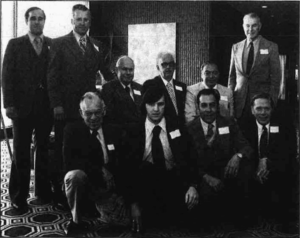
Members of Wallace Eannace’s western region sales team on hand for May 11 New Jersey Steam Seminar: (standing from left) Julian Ocejo, John Borst, sales manager Carl Slgl, service manager Harold Van Goor, Doc Eannace and field engineer John Rogers; (kneeling) ITT Fluid Handling manager of service training Joe Flasch, Paul Adamo, Frank Pineno and Walter Bosch, marketing manager for engineered products, based In Manhattan.
Samuel “Doc” Eannace’s path from the high seas to Kelly, Inc. was not quite as direct as that of his future partner’s. After high school graduation in Cliffside Park, N.J. in 1944 and two years of service on an aircraft carrier in the Pacific Theatre during the war, Doc came home to a laborer’s job with a roofing company (” … just to get some change in my pocket”). While attending Stevens Institute of Technology in 1946, Eannace signed on as a draftsman with Allied Chemical and Dye in Edgewater, N.J. After three years of in Doc’s words “drawing pictures and going crazy, ” Eannace submitted to a battery of aptitude tests at his night school as a prelude to a change in majors. The verdict that Eannace was a natural-born salesman gave scientific validation to what Doc already knew in his heart he had just accepted a sales trainee position with Kelly, Inc. the previous week.
Doc served his apprenticeship as a “chauffeur” for Kelly’s one and only Jersey representative, Charlie Leitch (now retired). “I would drive Charlie around to his accounts and make deliveries,” Doc remembers. “We had a stock room-actually it was more akin to a chicken coop-in the back of a filling station in Carlstadt, where we inventoried relief valves and a few booster pumps. The building had dirt floors and no heat, but we didn’t much care. The car was our office and all we were concerned about was building the territory.
“But one day, Mr. Schmidt came across the Hudson River for a visit,” Doc continues. “He took a look at the coop, pronounced us all crazy for putting up with it for so many years, and suggested that we find decent office quarters as soon as possible. We relocated in a building in East Rutherford, where we remained until the formation of Wallace Eannace in 1970.
“When Harold Schmidt died in 1956, George Wallace ascended to the presidency, cutting back on his outside sales duties to become more deeply involved in financial and administrative matters. The company continued to grow under Wallace’s direction, but by the end of the ’60s, the last member of the Schmidt family had departed the firm. And with the ownership of the company tied up in a trust, three key managers decided it was time for a change-but a change in name only, not in the style and substance which had proven so effective for the company since its founding.
George Wallace and Doc Eannace became the principal owners of the newly christened Wallace Eannace Associates, Inc., which consisted of the same personnel, facilities, product lines and markets as its predecessor organization. Hank Kunkel, who joined Kelly, Inc. in 1958 as an accountant, also acquired a partial interest in the new enterprise.
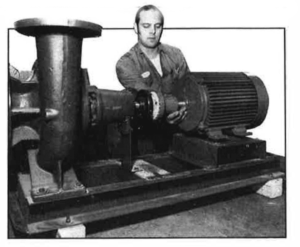
Warehouseman Bob HIiiman mounts motor on a centrifugal pump. Wallace Eannace service personnel can cut Impellers and mount motors to custom fit Job conditions.
Retaining the presidential title, Wallace functions as the firm’s chief marketing director and vendor liaison. He also supervises the Manhattan sales office on Fifth Avenue, a three-person operation, out of which marketing manager/engineered products Walter Bosch and another salesperson work.
The company divides its territory into two regions, with the Hudson River providing an approximate line of demarcation. The western section of New Jersey and the five lower counties of New York State come under the sales jurisdiction of the Franklin Lakes, N.J. office and warehouse complex. Executive vice president Doc Eannace oversees this facility’s operations. The eastern region, consisting of the five city boroughs, Long Island, Westchester County and the state of Connecticut, is the responsibility of the Plainview (Long Island), N.Y. office-warehouse facility. Secretary-treasurer Hank Kunkel is the main man here.
With sales in excess of $10 million, Wallace Eannace currently serves three major markets: wholesaler, commercial plan & spec, and industrial. 80% of the firm’s annual volume is derived from distributor sales on basic shelf items for residential and light commercial applications. Relatively few wholesalers become involved in the take-off stage of a commercial job, according to Wallace, preferring the MIR to communicate directly with the contractor on job specifications. If the contractor wins the job and decides to install Wallace Eannace’s material, then the sale will be funneled through a local supply house.
Wholesalers as a group also tend to avoid larger commercial and industrial projects, especially those involving custom designed pumps and heat transfer equipment whose engineering is quite sophisticated. This type of product will be assembled by the manufacturer and shipped directly to the installation site.
And on certain occasions, Wallace Eannace also performs custom design work on its own premises. “In addition to the regular shelf items, we also stock pump ends and bases,” Doc Eannace remarks. “Our service personnel can then cut impellers and mount motors to fit specific job conditions. This gives us much greater flexibility, both in servicing the customer and preventing our being shut out on certain sales opportunities for which the standard equipment sizes would not apply.”
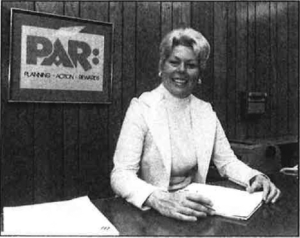
Audrie Cromwell ls operations manager of Wallace Eannace’s Frank/In Lakes, N.J. facility. She was also responsible for all the logistical preparations Involved In the steam and hydronics seminars held In Franklin Lakes, N.J. In September 1977 and in May of this year.
Wallace Eannace divides its staff of 56 employees into four service groups which cater to its markets.
1) Field Sales: These individuals are on the road full-time, dealing directly with customers. Specializing in one of the three major markets served by Wallace Eannace, the field salesman’s duties include promoting products, expediting orders and keeping catalogs up to date, as well as providing take-off services, pricing information and, of course, selling.
2) Product Service: Each sales region employs two men whose job it is to handle mechanical equipment problems. In-warranty repairs are performed either at the warehouse or in the field.
3) Field Technical Engineering: Working with consulting engineers or industrial plant personnel, these people become involved with product application questions and system breakdowns.
4) Customer Service/Inside Sales: This group offers more than a high priced answering service for the outside sales force. Highly product oriented, Wallace Eannace inside salesmen know and understand product applications, and can provide equipment sizing, selection and pricing information right over the telephone for the customer. Harold Schmidt brought the old John G. Kelly, Inc. to a position of market leadership with a philosophy that heavily stressed product specialization and superior engineering knowledge. Since 1970, Wallace Eannace Associates has sought to broaden these concepts, creating an altogether new corporate trademark: complete systems orientation.
“Most sales organizations confine their product knowledge strictly to those lines they represent,” Doc Eannace remarks. “If the scope of their lines is limited, so is their expertise. In other words, they’re basically hardware salesmen, and once their particular product is functioning properly within your system, that’s the end of the story for them. If the rest of your operation is on the fritz-well, there’s not much they can do about it.
“On the other hand, if your heating system is having problems, Wallace Eannace will not restrict its diagnostic services to that single pump or heat exchanger you might have purchased from us,” he continues. “Our engineering and technical people will evaluate the entire setup to discover a solution. This is because our product lines have sufficient depth and breadth to make our ‘system orientation’ approach more than just an empty slogan. We have the material and the service capability to perform.”
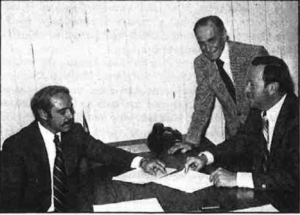
Wallace Eannace secretary/treasurer Hank Kunkel (right) oversees sales and operations at the firm’s Plainview office and warehouse complex. Here he Is seen conferring with sales manager Bob Azzolin (left) and operations manager Albert Parker.
Contact: Lisbeth Flores | LF@wea-inc.com | 800.932.4454
Source: Supply House Times

